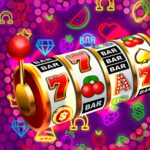A slot machine (American English), known variously as a fruit machine (British English), puggy (Scottish English),[1] the slots (Canadian English and American English), poker machine/pokies (Australian English and New Zealand English), fruities (British English) or slots (American English), is a gambling machine that creates a game of chance for its customers. Slot machines are also known pejoratively as one-armed bandits because of the large mechanical levers affixed to the sides of early mechanical machines and the games’ ability to empty players’ pockets and wallets as thieves would.
A slot machine’s standard layout features a screen displaying three or more reels that “spin” when the game is activated. Some modern slot machines still include a lever as a skeuomorphic design trait to trigger play. However, the mechanics of early machines have been superseded by random number generators, and most are now operated using buttons and touchscreens.
The first video slot machine was developed in 1976 in Kearny Mesa, California by the Las Vegas–based Fortune Coin Co. This machine used a modified 19-inch (48 cm) Sony Trinitron color receiver for the display and logic boards for all slot-machine functions. The prototype was mounted in a full-size, show-ready slot-machine cabinet.
Video slot machines do not use mechanical reels, instead of using graphical reels on a computerized display. As there are no mechanical constraints on the design of video slot machines, games often use at least five reels, and may also use non-standard layouts. This greatly expands the number of possibilities: a machine can have 50 or more symbols on a reel, giving odds as high as 300 million to 1 against – enough for even the largest jackpot. As there are so many combinations possible with five reels, manufacturers do not need to weight the payout symbols (although some may still do so). Instead, higher paying symbols will typically appear only once or twice on each reel, while more common symbols earning a more frequent payout will appear many times. Video slot machines usually make more extensive use of multimedia, and can feature more elaborate minigames as bonuses. Modern cabinets typically use flat-panel displays, but cabinets using larger curved screens (which can provide a more immersive experience for the player) are not uncommon.
Video slot machines typically encourage the player to play multiple “lines”: rather than simply taking the middle of the three symbols displayed on each reel, a line could go from top left to the bottom right or any other pattern specified by the manufacturer. As each symbol is equally likely, there is no difficulty for the manufacturer in allowing the player to take as many of the possible lines on offer as desire – the long-term return to the player will be the same. The difference for the player is that the more lines they play, the more likely they are to get paid on a given spin (because they are betting more).
To avoid seeming as if the player’s money is simply ebbing away (whereas a payout of 100 credits on a single-line machine would be 100 bets and the player would feel they had made a substantial win, on a 20-line machine, it would only be five bets and not seem as significant), manufacturers commonly offer bonus games, which can return many times their bet. The player is encouraged to keep playing to reach the bonus: even if he is losing, the bonus game could allow then to win back their losses.





















